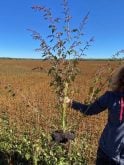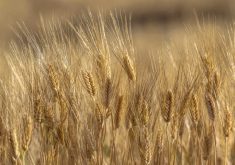Giant ragweed could be the first “made in Canada” weed resistant to the non-selective herbicide glyphosate, so it’s worth watching out for, says University of Manitoba weed scientist Robert Gulden.
Giant ragweed can be found in Manitoba, but it’s much more common in Ontario he told those participating in the Crop Diagnostic School here at the university’s Ian N. Morrison Research Farm July 17.
A farmer near the Windsor airport sprayed his Roundup Ready soybeans last year with glyphosate and the giant ragweed on about 50 acres didn’t die, Gulden said. The University of Guelph is investigating to see if the weeds are in fact resistant to glyphosate.
Read Also

Mazergroup’s Bob Mazer dies
Mazergroup’s Bob Mazer, who helped grow his family’s company into a string of farm equipment dealerships and the main dealer for New Holland machinery in Saskatchewan and Manitoba, died July 6 from cancer.
The field in question has been in Roundup Ready soybeans for eight years, Gulden said, as cereal crops are prohibited for fear of attracting birds and posing a threat to airport traffic.
“It’s (giant ragweed) probably not going to be a major weed in Western Canada, but it’s one we may have to deal with in the future,” Gulden said.
In the United States at least three fields have developed glyphosateresistant common ragweed after eight or so years of repeated exposure to glyphosate, Gulden said.
Canada fleabane is a weed also found in Manitoba. It normally requires a higher rate of glyphosate to control so it’s naturally predisposed to developing glyphosate resistance.
Glyphosate-resistant Canada fleabane is showing up in some horticultural fields in California, Gulden said. Herbicide-resistant fleabane is also spreading to fields where the weed has never been sprayed with glyphosate.
“The glyphosate-resistant population actually reproduces better than the susceptible population so it’s replacing it naturally and automatically,” Gulden said.
Researchers say herbicide-tolerant weeds occur through natural selection. When fields are repeatedly exposed to the same herbicide, susceptible weeds are killed, leaving mostly weeds that are naturally tolerant to the herbicide. The survivors cross and their offspring are often resistant too. As the population of resistant weeds grow in a field certain herbicides become useless on those weeds. [email protected]



















